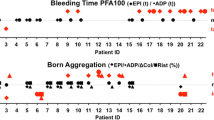Summary
In 39 patients with hemodynamically significant stenoses of the internal carotid artery thrombendarterectomy was performed. Hemorheological properties and plasma protein levels were studied pre- and postoperatively over a period of 14 days. In comparison to age-matched healthy controls preoperative plasma viscosity, red cell aggregation, fibrinogen, haptoglobin and alpha-1-antitrypsin were significantly elevated. After surgical trauma there was an increase in fibrinogen, alpha-1-antitrypsin, haptoglobin and ceruloplasmin, whereas alpha-2-macroglobulin, immunglobulin A and immunglobulin G decreased significantly. Plasma viscosity, red cell aggregation, red cell filterability, fibronectin and immunglobulin M remained unchanged. We conclude that our patients showed a non specific chronic “hematological stress syndrome” with raised acute phase reactants and corresponding hemorheological changes preoperatively; despite postoperative acute phase reaction no further deterioration of the rheological parameters could be observed; this might be caused by a decrease of plasma proteins with high frictional ratios compensating the increase of acute phase proteins. Besides, tissue damage and consecutive acute phase reaction in carotid arterial surgery seem to be of relatively minor degree.
Similar content being viewed by others
Abbreviations
- AP:
-
Akute Phase
- AT3:
-
Antithrombin III
- A1AT:
-
Alpha-1-Antitrypsin
- A2MG:
-
Alpha-2-Makroglobulin
- CER:
-
Coeruloplasmin
- EA:
-
Erythrozytenaggregation
- EF:
-
Erythrozytenfiltrabilität
- FGEN:
-
Fibrinogen
- FN:
-
Fibronectin
- HK:
-
Hämatokrit
- HPT:
-
Haptoglobin
- Ig:
-
Immunglobulin
- LEU:
-
Leukozyten
- PV:
-
Plasmaviskosität
- THR:
-
Thrombozyten
Literatur
Bouhoutsos J, Morris T, Chavatzas D, Martin P (1974) Then influence of haemoglobin and platelet levels on the results of arterial surgery. Br J Surg 61:984–986
Chao FC, Tullis JL, Alper CA, Glynn RJ, Silbert JE (1982) Alterations in plasma proteins and platelet functions with aging and cigarette smoking in healthy men. Thromb Haemostas 47:259–264
Colley CM, Fleck A, Goode AW, Muller BR, Myers MA (1983) Early time course of the acute phase protein response in man. J Clin Pathol 36:203–207
Crockson RA, Payne CJ, Ratcliff AP, Soothill JF (1966) Time sequence of acute phase reactive proteins following surgical trauma. Clin Chim Acta 14:435–441
Dintenfass L (1985) Influence of plasma proteins on the in vivo and in vitro rheological properties of blood. Clinical Hemorheology 5:191–206
Fischer CL, Gill Ch, Forrester MG, Nakamura R (1976) Quantitation of “acute-phase proteins” postoperatively. Value in detection and monitoring of complications. Am J Clin Pathol 66:840–846
Hamer JD, Ashton F, Meynell MJ (1973) Factors influencing prognosis in the surgery of peripheral vascular disease: Platelet adhesivness, plasma fibrinogen, and fibrinolysis. Br J Surg 60:386–389
James K, Merriman J, Gray RS, Duncan LJP, Herd R (1980) Serum alpha-2-macroglobulin levels in diabetes. J Clin Pathol 33:163–166
Kiesewetter H, Jung F, Ladwig KH, Waterloh E, Roebruck P, Schneider R, Kotitschke G, Bach R (1986) Prädiktorfunktion hämorheologischer Parameter im Hinblick auf die Inzidenz manifester Durchblutungsstörungen: Konzept der Aachen-Studie. Klin Wochenschr 64:653–659
Koppensteiner R, Jung M, Watz S, Ehringer H (1986) Red cell aggregation in healthy volunteers — dependence on age and cigarette-smoking. Proceedings 14th World Congress International Union of Angiology. W. Zuckerschwerdt, München Bern Wien, pp 514–516
Koppensteiner R, Jung M, Minar E, Konecny U, Ehringer H (1987) Erhöhte Trombozytenaggregation ohne weitere hämorheologische Veränderungen bei Patienten mit rezenten transitorischen ischämischen Attacken. VASA Suppl 20:247–249
Lackner FX, Graninger W, Khosropur R (1985) The effect of isovolemic haemodilution on infection-related serum protein levels. Eur J Anaesth 2:20–30
Mc.Millan DE (1976) Plasma protein changes, blood viscosity and diabetic microangiopathy. Diabetes 25 (Suppl 2):858–862
van Ooost BA, Veldhuyzen BFE, van Houlwelingen HC, Timmermans APM, Sixma JJ (1982) Tests for platelet changes, acute phase reactants and serum lipids in diabetes mellitus and peripheral vascular disease. Thromb Haemostas 48:289–293
Reizenstein P (1979) The haematological stress syndrome. Br J Haematol 43:329–334
Rudofsky G (1984) Postoperativer Verlauf von hämodynamischen und hämorheologischen Parametern. Kiesewetter H, Ehrly AM, Jung F (Hrsg) Hämorheologische Meßmethoden. Münchner Wissenschaftliche Publikationen, S 265–266
Scheffler A, Rieger H (1984) Die Erythrozytenfiltration — Eine klinisch relevante Methode zur Charakterisierung der „Erythrozytenfließfähigkeit“ im Rahmen der arteriellen Verschlußkrankheit? VASA Suppl 12:81–97
Schmid-Schönbein H (1982) Physiologie und Pathophysiologie der Mikrozirkulation aus rheologischer Sicht. Internist 23:359–374
Schmid-Schönbein H, Volger E, Teitel P, Kieswetter H, Dauer U, Heilmann L (1982) New hemorheological techniques for routine laboratory. Clin Hemorheology 2:93
Schmid-Schönbein H, Weiss J, Ludwig H (1973) A simple method for measuring red cell deformability in models of the microcirculation. Blut 26:369–379
Stuart J (1984) The acute-phase reaction and haematological stress syndrome in vascular disease. Int J Microcirc Clin Exp: 3:115–129
Stuart J, George AJ, Davies AJ, Aukland A, Hurlow RA (1981) Haematological stress syndrome in atherosclerosis. J Clin Pathol 34:464–467
Tillmann W, Lakomek M, Heidemann P, Behrens-Baumann W, Schröter W (1984) Aggregate formation of erythrocytes and diabetic retinopathy in children, adolescents, and adults with diabetes mellitus (type I). Klin Wochenschr 62:1136–1139
Voulgari F, Cummins P, Gardecki TIM, Beeching NJ, Stone PCW, Stuart J (1982) Serum levels of acute phase and cardiac proteins after myocardial infarction, surgery and infection. Br Heart J 48:352–356
Wilhelmsen L, Svärdsudd K, Korsan-Bengdsen K, Larsson B, Welin L, Tibblin B (1984) Fibrinogen as a risk factor for stroke and myocardial infarction. New Engl J Med 311:501–505
Author information
Authors and Affiliations
Rights and permissions
About this article
Cite this article
Jung, M., Koppensteiner, R., Graninger, W. et al. Hämorheologie und Akute Phase Reaktion nach Thrombendarteriektomie der extracraniellen Arteria carotis. Klin Wochenschr 66, 379–384 (1988). https://doi.org/10.1007/BF01737940
Received:
Revised:
Accepted:
Issue Date:
DOI: https://doi.org/10.1007/BF01737940



